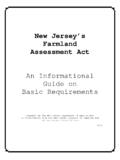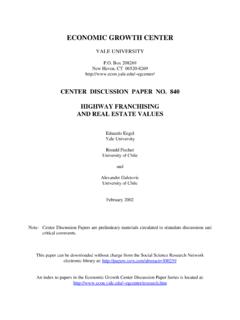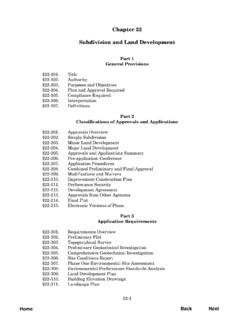Transcription of LABOUR'S FLAWED LAND ACTS 1947-1976
1 LABOUR'S FLAWED land acts 1947-1976 . V. H. Blundell Contents Introduction The 1947 Town and Country Planning Act The land Commission The Community land Act The Development land Tax Summary Introduction Since 1945, many attempts have been made by both labour and Conservative governments to pass legislation which would have direct or indirect bearing on land economics. Most of that legislation, from LABOUR'S Town and Country Planning Act of 1947 down to the Conservative introduction of the Community Charge in the late 1980s, produced very important side-effects which were obviously not expected. These side-effects arose through a failure properly to appreciate certain fundamental economic principles, including the very meaning of the word " land ".
2 land reformers of various kinds have long contended that the adverse effects of the land tenure system prevailing in England and Wales, and also (with some important variations) in Scotland, lead directly and indirectly to a wide range of social and economic problems. Among these are high costs of housing, homelessness, unemployment, high taxation and recurrent industrial depressions. The present publication is primarily concerned with those particular aspects of the " land question", although some reference will be made to other aspects as well. In the early part of the 20th Century, agitation for land reform became a major political issue. In 1903, the Conservatives enacted some important land legislation relating to Ireland, whose effects, good and bad, are visible in both the north and the south to this day.
3 A few years later, their Liberal successors attempted to assess land values in Scotland as a preliminary to taxation, but were frustrated by the House of Lords. The land taxing clauses of Lloyd George's 1909. Budget inaugurated one of the most intense periods of political controversy in modern history. There was continuing interest in land reform in the inter-war years: substantial legal reforms achieved by the Conservative government in 1925; the derating of agricultural land in 1929; the effort of the labour Government in 1931 to assess and tax land values; and the unsuccessful London Rating (Site Value) Bill of 1938. We are here concerned with legislative measures which have been made, or attempted, since 1945. It will not consider all legislation which has some bearing on land - that would be an almost impossible task - but only the legislation which was primarily intended to secure for the community some of those land values which were created by the community, but in practice were captured by private individuals.
4 It is the view of the author that in many - perhaps most - of these cases Parliament was motivated by creditable principles, but that the effects actually produced were widely different from those intended, and sometimes the very reverse, through a misunderstanding of the underlying economics. If Britain is to undergo a further spate of land legislation in the future, it is important that the strengths and weaknesses of past measures should be clearly understood, in order that avoidable errors should not be repeated. Definition The word " land " will be used repeatedly. The term is here usually employed in its economic sense, to cover all natural resources. In actual pieces of legislation, however, the word is used in its legal sense, which includes buildings and other developments set upon land .
5 These two usages of the same word must perforce be followed, but it is important that the reader should appreciate the ambiguity. The Town and Country Planning Act, 1947. i. The background In the first half of the 20th Century, both the labour and Liberal Parties were more or less formally committed to land value taxation. A considerable number of Conservatives, including Winston Churchill, showed much sympathy with the idea as well. When the labour Party came to power in 1945, it was eagerly expected by many of its supporters, and by land reformers generally, that land value taxation would be introduced. The Town and Country Planning Act which was passed in 1947 is famous for a number of its provisions. It greatly strengthened the control of local authorities over planning and land use.
6 These elements of the Act are important, but they lie rather outside the present study. The provisions which are most relevant here are those which concerned "betterment" values. The Act brought together the recommendations of the Scott, Barlow and Uthwatt Reports, which drew attention to the high cost to local authorities and government corporations of acquiring land for development. These Reports noted that, as soon as development was mooted, a "cloud" of value descended on the designated area, and up went the price of land . This "cloud" of land speculation followed the planners around the country. If planning decisions by public authorities gave rise to increased land values, it was argued, then the "betterment" of land value should pass to the community, and not to the landowners.
7 Hence a "betterment" charge should be levied. All increases in land values which were not related to planning permission, however, were to be excluded from this charge. The architects of the Act claimed that it would end land speculation, force land into use, and ensure that increased land values arising from the release of land for development accrued to the community. ii. Provisions of the Act The basic provisions of the Act which are relevant here were as follows: a. The right to develop land became a state monopoly, and permission to develop, or change the use of, land had to be bought from the newly-created Central land Board. The definition of "development" was therefore not confined to construction on vacant sites and the re-development of existing buildings.
8 It also included the change of use of buildings from one business to another. b. When "development", within the special meaning of the Act, required planning permission, it attracted a Development Charge. The Act, however, laid down twenty-two classes of undertakings or occupations which were to be considered as of a similar nature. A change of use within a class was not deemed to involve "development", and was therefore exempt from Development Charge. But a change of use from one class to another required planning permission and, if granted, attracted a Development Charge. As an example, shops as such were not a single class of use. The class into which a shop was placed depended on what it sold. A person could not change from selling sweets to selling meat, or vice versa, without planning permission - which, if granted, made him liable to a Development Charge.
9 C. The method of calculating the amount of Development Charge payable was to take the assumed selling value of a property if it was confined to its present use "existing use value", as this was called - and deduct this from the value of the property with permission for its development potential to be realised. The difference between the two values was taxed at 100 per cent. d. A sum of 300 millions was made available as compensation to land owners who could claim hardship because their land was ripe for development, but the Central land Board had refused them the right to develop. The Act was passed in August 1947, and the planning sections took effect shortly afterwards. The rest of the Act, which included the Development Charge ( ) came into effect in July 1948.
10 Iii. Weaknesses of the Act Although the Act was clearly an attempt to capture land values for the people, it had many practical defects. Anomalies and absurdities abounded, and even before the legislation came into operation many people in the professions concerned with development and use of land and buildings were alarmed at the complexity of rules, regulations and Orders. Mr Silkin, Minister of Town and Country Planning, admitted in a debate in the Commons (26 May 1948) to having second -or even third - thoughts on this "highly intricate matter". So complex was the Act that civil servants were sent round the country to address meetings on the workings of the Act for the benefit of those in local government and the professions who had to interpret, advise on, or administer the regulations.




